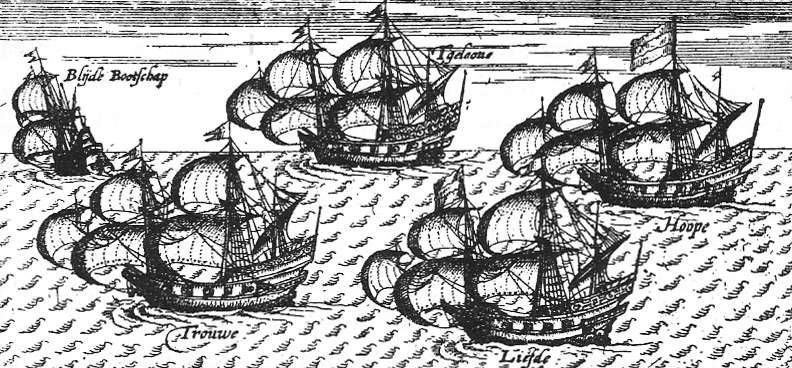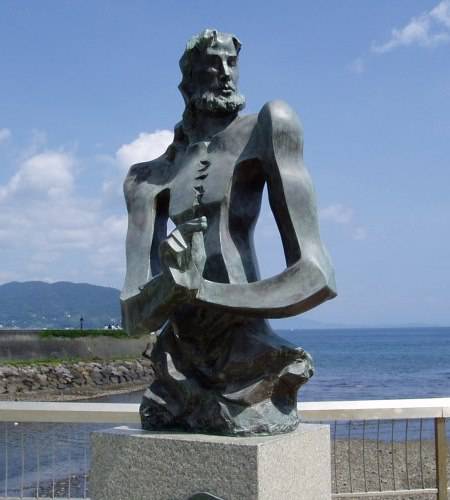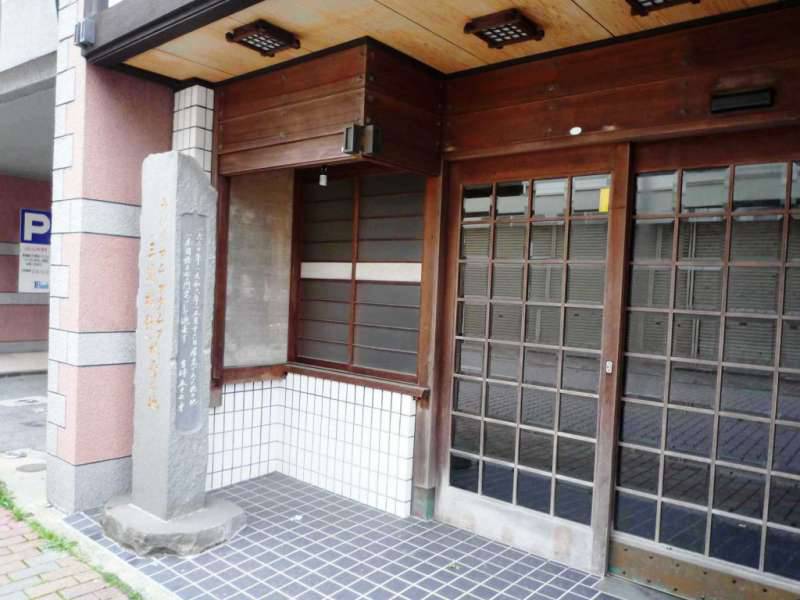Anzin-Miura - samurai-englishman (part one)
East is East,
and they will not leave the place.
Until heaven and earth appear
on the Last Judgment.
But there is no East, and there is no West, that -
tribe, birthplace, race,
If strong with a strong face to face
At the edge of the earth rises?
Rudyard Kipling (1865 - 1936). Translated by E. Polonskaya.
Until now, TOPWAR has been talking about samurai who were born and raised on Japanese soil. but stories it was pleasing to make one of the samurai become ... an Englishman named William Adams! Moreover, he gained confidence in the shogun Tokugawa Ieyasu, and for many years was his closest adviser, and not only directly influenced the foreign policy of the Japanese state, but also became a valuable source of information for the Japanese. It was thanks to him that they learned the scientific and practical knowledge they needed in the field of geography, mathematics, navigation and shipbuilding. In this sense, he did more for them than any of his predecessors, the Portuguese or the Spaniards, who came to Japan long before him!

Of course, Will Adams didn’t look that way, but Richard Chamberlain played him very well as Blackxorn’s navigator in the Shogun series, which was filmed from the novel by the American writer James Clivewell.
Amazingly, the Japanese still keep the memory of William Adams. Not far from Tokyo there is a small hill called Andzintsuka - “Navigator's Hill”. It received its name in honor of Will Adams. Among the Japanese, he was known as Miura Anzin - "Navigator from Miura." In this place was a manor, presented to Tokugawa Ieyasu. In the small cozy town of Ito, located on the Izu Peninsula, on the shores of Sagami Bay, is a monument to Adams. It was here, at this place, in 1605 – 1610, that Adams was the first in Japan to begin building keel ships. In memory of this, the inhabitants erected this monument. And in Tokyo, one of the city blocks, where Adams’s house was among the great multitude of houses, was named Anjin-te, “Navigator's Quarter”.
At one time, Adams's compatriot wrote about the compatibility of East and West: "The West is West, the East is East, and they will not leave the places ...". Adams tried to rally these two polarically different civilizations in his culture.
Events developed at the junction of the distant XVI – XVII centuries. In those days, Japan began to actively enter the foreign market, sixteen states were already on the list of the country's trading partners. Note that trade was only one of the sides of the huge polyhedron of Japan’s relations with other countries. The Land of the Rising Sun extremely actively expanded the sphere of its interests to the neighboring countries. And this was done far from always in a peaceful way, since it is necessary to act to respectable neighbors. Japan’s external expansion, sometimes aggressive, was quite varied, from Hideyoshi's aggressive campaigns to Korea to attempts by Japanese pirates to seize neighboring lands. The purpose of the seizures was the creation of permanent settlements. Captives were also subject to countries far away from Japan. The lands were settled in the Philippines, and in Siam, as well as on the east coast of the Indochinese Peninsula. The islands of Indonesia and the coast of Malaya were also not ignored by the ubiquitous Japanese. The Indochina countries were under the complete control of the Japanese, since the management of external relations was in their hands.
As we see, the Japanese over-activity was explained by their territorial interests. And the reasons were the most common, similar to the goals of overseas merchants and seafarers, who climbed farther and farther from their native shores: the rapid growth of trade relations, the establishment of more and more new economic relations.
At that time, the first acquaintance of the Japanese with the Europeans took place. The result of such meetings was obtaining permission to import firearms. weapons to Japan. Six years later, the Portuguese Jesuit Francisco Xavier arrived in Japan with a missionary task: Christianity as a religious movement had to find its followers in this country too. Emperor active spread of Christianity was alarming: Japan was threatened by the influence of foreign states, and, consequently, the loss of its sovereignty. And the situation in the meantime became more intense. The consequence of this was a decree signed by the emperor in 1597, strictly forbidding the practice of Christianity. The punishment for disobedience was severe: the death penalty. All the preachers of the new faith were immediately expelled from the state, and a wave of executions swept through the country. Dozens of people lost their lives, and the churches were destroyed. Hideyoshi dies at this time. A logical continuation of these sorrowful events for the country becomes a turmoil, culminating in the battle of Sekigahara in 1600. At the same time, William Adams arrives in Japan on the Lifde ship, the only survivor of the whole squadron.
No one knows when William Adams was born. One thing is certain: little William was dubbed 24 September 1564, as recorded in the parish book of the city of Gillingham. When the boy was twelve years old, he left his father's house and went to Limehouse, a port city on the banks of the Thames. There he was accepted as a student by the master of ship affairs, Nicholas Diggins. Learning craft lasted a long time. But study has come to an end. The coming 1588 year becomes a landmark for William: he was taken as a skipper to the ship “Richard Duffield”. Small in displacement (120 tons), it was serviced by a team of 25 people. It was the first independent swimming of a twenty-four year old, promising young man. Excellent recommendations of a mentor, hard work, dedication - all this taken together and became a happy ticket to the adult life of a very promising skipper. "Richard Duffield" at that time was involved in the supply of ammunition and food supplies to British ships who fought with the Spanish "Great Armada", so he was fortunate enough to take part in this important historical event.
A year later, William was married to a girl named Mary Hin. The sacrament of marriage took place in the church of St. Dunston in Stepney. Quiet marital happiness was short lived. The sea was and remained for William the greatest love, the most important thing that was in his life. The 1598 year was for Adams a year of participation in a risky business, the goal of which is to get to the shores of the Far East across the Atlantic and Pacific Oceans. It is not known how the negotiations were held on the subject of the campaign, and who was the first to offer his services — William himself or the Dutch traders. As a result, Adams again became a navigator on one of the ships equipped for this expedition. If Adams knew what kind of bizarre turns in life fate had prepared for him ... The decision, finally and irrevocably, would become the starting point of a new life, perhaps more interesting, but, alas, without a homeland. William will never see England again. The upcoming departure was difficult not only for William, but also for his young wife, who had recently given birth to a lovely daughter named Deliverens. And although for sailors who went on a long and very dangerous journey, parting with loved ones was always a familiar affair, Adams left his wife and daughter with a heavy heart.
Starting on a long journey to the shores of the Far East, the sailors were ready for any, the most difficult situations. The situation was extremely difficult, because the expedition members were Protestants, and their path lay through the ports of the South Seas, where Spaniards Catholics prevailed. The difference in religion was a major obstacle in the relationship between potential companions.
God only knows what was destined to be experienced by the sailors on this voyage. The coast of Japan has reached a single, miraculously survived vessel, called the Lifde. As far as it was a difficult undertaking, and what the Lifde seamen experienced, this fact says. When in April 1600 of the year, after a long and incredibly dangerous voyage, the Lifde approached Japan, only seven people, including Adams, were able to go down to the shore on their own. The rest barely walked around the deck of the ship, and some people could not do that either. At this team misfortune is not over. A few days later, three crew members died, and later - three more. Curses and insults rained down on Adams's head, especially in the last, most terrible weeks of the campaign, he was the only one who wanted to finish the expedition.

Adams squadron ships.
Coming ashore, the sailors went to the nearest temple and placed there his bow figure, taken from the ship. Many years later, sailors came to the temple to this statue, begging for her patronage and protection in their difficult task. Later, the statue was moved from this temple to the Imperial Museum in Tokyo "for permanent residence."
But William Adams could not even imagine what would be in the very center of events unfolding off the coast of Japan. A civil war was raging in the country at that time. Just when the Lifde entered the waters of Japan, one of the great Japanese daimyo, Tokugawa Ieyasu, arrived with a courtesy visit to Osaka Castle to the young Hideyori. But the daimyo’s plans were to quickly get rid of the great Hideyoshi's heir, Ieyasu did not need competitors. They were introduced to William Adams. Ieyasu was interested in the cargo that was on the ship. And there was something to profit there: wicker muskets, cannonballs, chain kernels, five thousand pounds of gunpowder, as well as three hundred fifty incendiary shells.
The contents of the holds inspired Ieyasu. Still would! So much ammunition, which turned out to be very useful! In 1542, the Portuguese brought firearms to Japan by sea, and they taught the Japanese to use them. Ieyasu captured weapons and ammunition, then quarreled with all members of the Regency Council and declared "war" with peace of mind. During the great battle of Sekihagara, Ieyasu used guns from the ship of Will Adams (although historians deny this fact). The outcome of the battle was decided on 21 on October 1600.
Then Ieyasu won this battle and became the sole ruler of Japan. After three years, the Japanese emperor publicly recognized the authority of Ieyasu and honored him with the title of shogun. Having thus secured a future for his son, Ieyasu set about strengthening Japan’s power. Being an insightful and extremely intelligent man, he understood that developed trade would not only strengthen the country economically, but also allow him to increase his personal wealth, and therefore the power of the clan. Therefore, the establishment of trade and business relations between the countries were a priority for Ieyasu. For this, he closed his eyes to the presence in the country of missionaries from Spain and Portugal, and even put up with the Jesuits, not without the help of whom, by the way, the Europeans learned about Japan and about the Japanese.
Francisco Xavier wrote about the Japanese as an amazing nation with qualities that should be present with every nation in an amicable way. And although he called the Japanese pagans, there was probably no equal nation in any country. Xavier noted in the Japanese integrity and gentleness. He called them people of honor, for whom she is above all, therefore they do not play in gambling, considering it to be dishonest. Most of them are in poverty, they are not shy about it, and commoners and nobles are treated with the same respect, which Christians do not have.
Of course, the Catholics from Portugal did not want to see next to them any competitors either among the Dutch or the British. The Jesuits, according to Adams, did everything to put the Lifde team as a pirate, and, therefore, very unreliable, moreover, dangerous. Allegedly, this team arrived in Japan not to trade, but to rob and kill. Having found out about the solid arsenal that was in the Lifde holds, the Jesuits, with a tripled force, began to slander the crew of the vessel, arguing that a ship arriving at the port for peaceful purposes would not have so many weapons on board. And therefore, these are not harmless merchants, but (oh, horror!) Real pirates.
Tokugawa Ieyasu was a man who had his own judgment. Not yielding to the entreaties to destroy foreigners, he decides first to find out what these strangers are, not so similar to the Portuguese, and what danger to expect from them. To this end, he gives the order to deliver to him the captain of the ship. Dutchman Jacob Quakernac, captain of the Lifde, was still too weak after a long and extremely difficult voyage. And so for an audience with Ieyasu did not fit. Adams turned out to be one of the few members of the team who felt quite tolerably until the end of the journey; he was sent ashore to the shogun. And the most important criterion that decided the fate of Adams was his excellent knowledge of the Portuguese language, the chosen language for communication between the Japanese and Europeans.
Obeying the will of the team, Adams went ashore. A "Lifde" together with the remaining members of the ship crew during the absence of the captain was sent to the port of Osaka. Such was the order of Ieyasu. At the beginning of his speech, Adams introduced himself and explained that he was English. Then he talked a little about his homeland - England, where this country is located, about the British desire to establish trade relations with the Far East. At the same time, he stressed that such trade relations would be extremely useful and beneficial for both parties.
After listening with great attention to Adams' fervent speech, Ieyasu understood the essence of the conversation, but deep down he still doubted the veracity of the words. The vague feeling that trade was not the main goal of arriving in Japan did not leave Ieyasu. It is possible that the suspicions of the Japanese are not unreasonable. After all, the very fact of having weapons on board the ship questioned the most convincing arguments of Adams. Therefore, Ieyasu asked Adams about the participation of England in the wars. The Briton replied promptly:
- Yes, England is at war, but not with all countries, but only with the Spaniards and the Portuguese. With the rest of the nations the English live in peace.
Ieyasu was satisfied with this answer, and the conversation smoothly moved to another plane. The topics of the questions were very diverse, sometimes very different in subject matter from one another: this applied to religion and the route of the ship from England to Japan. In advance of taking maps and locations with him, Adams showed the ship’s route from the shores of Holland across the Atlantic Ocean, the Strait of Magellan and the Pacific Ocean to Japan. The shogun, who understood little in geography, found this story extremely interesting and informative. In this vein, the conversation lasted until midnight.
There was one more question that tormented Ieyasu, and to which I wanted to get a truthful and comprehensive answer: the presence of the goods on the ship and its purpose. Provident Adams honestly read the entire list of goods. And at the end of a lengthy conversation, Adams dared to ask the highest permission to trade with the Japanese, as the Spaniards and the Portuguese did. Shogun's response was suspiciously fast and incomprehensible. And then, without explaining anything, Adams was taken from Ieyasu and put in a prison cell, where he stayed, awaiting the decision of his fate and the fate of his comrades.
The favorable impression made on Ieyasu played a positive role. The picture was spoiled only by the fact that there was an arsenal on board. Two days passed, and Adams was again called for a conversation. The conversation was long and thorough. There was one topic: the hostilities in which Britain took part, as well as the reasons for Britain’s hostility with Portugal and Spain. Having received exhaustive answers to his questions, the shogun ended the conversation and ordered the prisoner to be taken to the cell.

Monument to Will Adams in Ito, Japan.
And although Adams’s conditions in the cell became softer, being in ignorance was unbearable. A month and a half passed in the complete absence of information. Adams did not know what was going on outside: that the Jesuits had planned, and whose side Ieyasu would take. Every day I spent waiting for the death sentence. But more fear was instilled in the torture to which those sentenced to death are subject to in Japan.
Fortunately for Adams, the six-week stay in the cell was over, and he was again called in for questioning. During the last conversation, Adams managed to dispel the shogun’s last doubts, after which William was released to the ship in peace.
Seeing Adams alive and well, the jubilation of the team knew no bounds. Many cried, because they no longer hoped to see William alive. Adams was shocked by such a manifestation of feelings. According to the stories of friends, they became aware that Adams was allegedly killed by order of Ieyasu, and no one hoped to see him alive.
After a stormy meeting with the team and retelling of all News Adams discovers that the personal items left on the ship inexplicably disappeared. Among the missing things, in addition to clothing, were especially valuable: marine tools and books. Of the cards, only those that William took with him to Ieyasu were preserved, and the clothes that were on him. Missing things from all team members. The Lifde team was forced to complain to Ieyasu, and he ordered that the stolen be returned to the sailors immediately. Alas, fearing the inevitable punishment, lovers of easy money hid the stolen even further, and victims of looting received only a small part of the missing. Compensation in cash amounted to 50 thousand Spanish doubloons at all. However, almost all of them went to cover the debt on food and housing. While Adams was in prison, the team survived as best they could. Compassionate Japanese gave food and shelter in debt.
House in Hirado, in which Will Adams died.
Soon the Japanese officially announced that none of the team members had the right to leave their country. The Dutch began to rebel, and three or four of the most resolute put forward demands that all the remaining money be divided in equal parts among the team members. And although Adams and Captain Jacob Quakernak resisted this demand, they still had to make concessions because they were in the minority. No sooner said than done. The remaining doubloons were divided between the sailors, after which they, having said goodbye to each other, dispersed throughout the country. It is noteworthy that since that time, none of them, except for Adams, Quakernak and another sailor, knows anything.
(To be continued)

Information